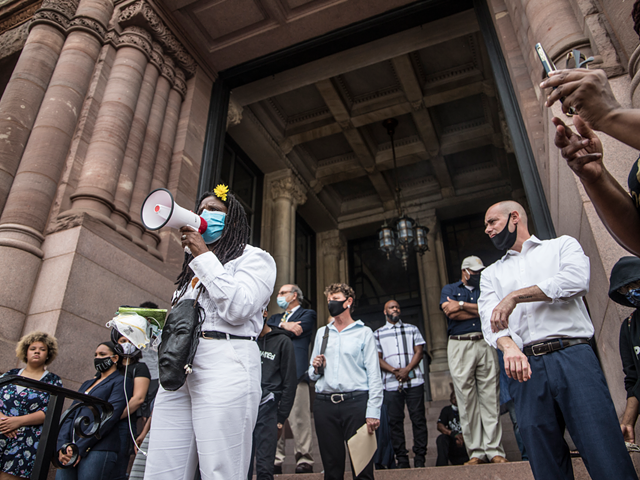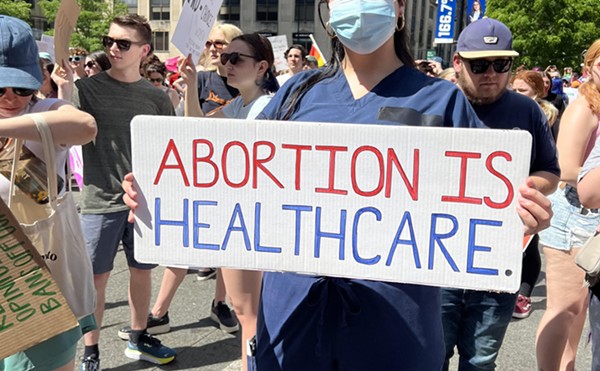Ohio Gov. Mike DeWine and Ohio Department of Health Director Dr. Amy Acton have received national praise for the speedy and deliberate action taken to slow the spread of the coronavirus in the state. While approval ratings for both remain high for now, the question will be what those numbers, and Ohio's COVID-19 stats, look like two to four weeks from now.
DeWine announced yesterday that bars, restaurants, barber shops and salons can join retail, manufacturing and general offices in reopening, at least to some degree, next Friday. Parts of the reopen plan, DeWine's decision to allow bars to open, for instance, have drawn concern.
Because for all the steadfast gumption the governor showed in shutting Ohio down early, there's now a feeling he's reopening too fast, swayed by the dollars-over-lives sect who think it's their God-given right to throw more low-paid workers on the frontlines to get infected so they can make a buck.
While much of the reopening of Ohio will be dictated by the appetite of the public to, well, go out in public, and everyone's willingness to abide by the state's recommendations to wear a mask and socially distance, we've bent the curve here and elsewhere because DeWine and others have eliminated that appetite as part of the state's strategy to combat COVID-19. That's ending.
With the reopening, it's back to trusting human beings, who are by and large big dumb selfish animals.
Meanwhile, Ohio's neighbors are taking a slower route.
In his COVID-19 press briefing on May 7, Kentucky Gov. Andy Beshear announced the next wave of business openings for the state economy.
Beshear is calling this the Healthy at Work Phase 2 and said all businesses slated to reopen must still follow the state's 10 rules of staying healthy at work as well as industry-specific guidelines. If guidelines haven't be released yet for a specific sector, the governor's office said they will be issued as soon as possible.
Here's what can open when:
May 22 – Restaurants, with limited 33 percent capacity and outdoor seating
June 1 – Movie theaters, fitness centers
June 11 – Campgrounds, public and private
June 15 – Child care, with reduced capacity; and potentially low-touch and outdoor youth sports
“That is when we are opening our restaurants on a limited inside capacity plus unlimited outdoor seating if they can get the spacing that is needed,” Beshear said in a press release. “This allows restaurants to be open for Memorial Day weekend, but please be careful.”
During Phase 3, which he said is coming July 1, bars will be allowed to reopen, with limitations, and gatherings of up to 50 people will be allowed to resume.
And our sister paper, Detroit Metro Times says, day by day, Michigan is slowly bending the coronavirus curve, with metro Detroit leading the way. (The below information is a collection of their reporting.)
The state reported 93 new coronavirus deaths on Thursday, bringing the state’s total to 4,343. Michigan now has more than 45,600 confirmed cases, up 592 in the past 24 hours.
At the peak out of the outbreak in early and mid-April, metro Detroit accounted for 80 percent of the confirmed infections in the state. On Thursday, only a third of the new cases were in Wayne, Oakland, and Macomb counties.
But as the rate of new cases declines in metro Detroit, outbreaks are cropping up in western Michigan counties.
“We’re still seeing outbreaks across the state that is of concern,” Dr. Joneigh Khaldun, the state’s chief medical officer, said at a news conference Thursday.
In Kent County, the largest county outside of metro Detroit, the number of positive cases more than doubled in the past two weeks, from 906 to 2,076. Kalamazoo saw a similar increase, from 266 to 561. And in Ottawa County, the number of infections nearly doubled, from 167 to 331.
During the same period, Berrien and Muskegon counties each saw a 69 percent increase in cases.
By comparison, metro Detroit's new cases increased 14 percent in the past two weeks.
Gov. Gretchen Whitmer on Thursday extended her stay-at-home order through May 28, three days after Memorial Day. Even though the rates of new deaths and positive cases are declining, the daily numbers are still high and could flare back up if the state eases restrictions too quickly, the governor said during a news conference Thursday.
“The number of cases we’re seeing is starting to plateau because your staying at home is making a difference,” Whitmer said. “It’s terribly important that we don’t let our guard down, and we consider this a real threat because it is.”
Whitmer is slowly reopening the economy, beginning with the construction industry this week. She is phasing in manufacturing next week, but she cautioned it could be another two weeks before additional sectors reopen.
“It’s important that we remember that we re-engage like a dial, not like a switch we turn on and off,” Whitmer said. “This staged recovery is so critical. We have to continue to move incrementally and measure our data incrementally.”
One of the requirements to further ease restrictions is ensuring plenty of unused beds and ventilators are available at hospitals, which were overwhelmed in metro Detroit in early April. Over the past three weeks, the number of COVID-19 patients in the hospital has dropped by more than half, from 3,918 to 1,737. During the same period, the number of patients on a ventilator dropped 51 percent, from 1,212 to 596.
On Thursday, the field hospital at the TCF Center in downtown Detroit closed because it had no more patients. Designed to house as many as 1,000 COVID-19 patients, it never saw more than 14.
"At the time that it opened, we were on a straight line up," Mayor Mike Duggan said Thursday, pointing to a chart showing the city's peak of new cases in early April. "It was a very reasonable conclusion that we were going to need 1,000 more hospital beds."
Duggan called the closure "a point of great celebration" and "a remarkable accomplishment," proof that social distancing efforts worked to keep the virus at bay.
Another critical step to reopening the economy is an abundant capacity. The state's goal is to test 15,000 people a day to get a more accurate picture of the spread and catch early signs of outbreaks. In April, the state tested an average of 5,700 people a day. That number increased to 9,400 tests a day so far in May.
"We're ramping up testing significantly," Khaldun said.
Another sign of progress is the declining rate of people who are testing positive. In early April, about 40 percent of the tests were positive. That rate has dropped to 8 percent.
One troubling area is the state's prisons, where the number of new cases jumped from 485 to 2,036 in the past three weeks. During the same period, the number of deaths rose from 12 to 50. Inmates filed a federal class-action lawsuit last week, accusing the Michigan Department of Corrections of failing to adequately protect them.






